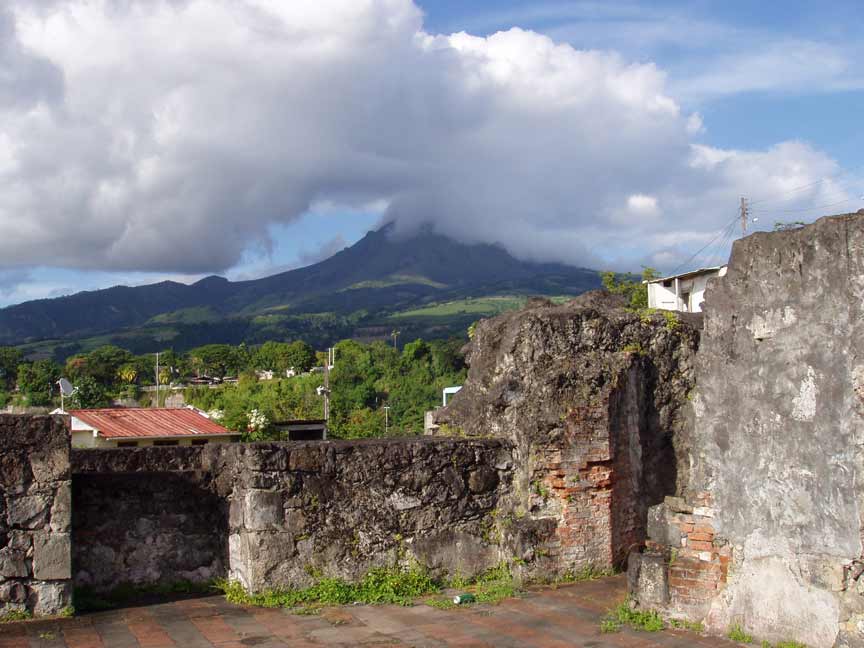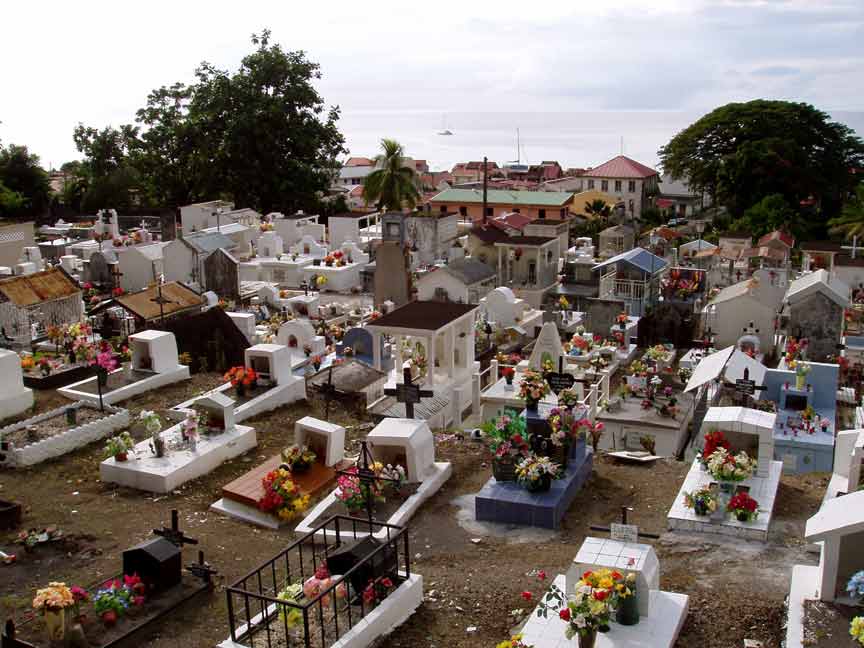St. Pierre, Martinique

Harmonie
Don and Anne Myers
Mon 14 Jan 2008 21:21
|
14:44.424N 61:10.684W
As planned, we sailed from Falmouth Harbour,
Antigua to St. Pierre, Martinique on Tuesday (1/8). The trip went faster
than we anticipated, taking only about 24 hours. It was the best (defined
as most comfortable) sail we've had since arriving in the Caribbean. The
winds were relatively light (non-existent sometimes when passing by the islands
of Guadeloupe and Dominica causing us to motor about 6 hours out of the 24) and
the waves were quite a bit smaller than the usual 6 to 8 feet. I am on
watch duty in picture 1. Note the smile and relaxed demeanor.
Usually when on watch I'm holding on with both hands and sitting rigidly in
the captain's chair. Here's hoping we have more sails like this one
in our future. Overnight we were accompanied by about ten cruise and cargo
ships, all basically heading in the same direction as we were. None tried
to ram us though, so that was a happy thing. There was no moon, but the
stars were out in force and the sky was clear so we had a grand view of the
stars. We are not celestial experts, but the night sky is so different
than what we are used to seeing at home. Not only are about a billion more
stars visible, but the constellations are very different. Our old friend
the Big Dipper is still visible, but in a strange position - it looks more like
a question mark than a dipper. When the moon does make an appearance, it
is sideways so it looks like a smiley face instead of a crescent. When a
partial moon sets, it looks like a smiley face sitting on the ocean
surface. It's such a strange sight it often looks fake.
We arrived alongside Martinique exactly at sunrise
on Wednesday and were greeted by an amazing site. The other islands we
have visited so far have been mountainous, but not spectacularly so.
Martinique is spectacular. Our fist sight was the 4,500 foot peak of Mt.
Pelee (picture 2). This volcano is famous for erupting in 1902 and
completely wiping out the town of St. Pierre, killing about 26,000 people.
We are anchored right outside the town of St. Pierre and have taken several
walks around so we can attest to the charred ruins that still exist peppered
everywhere throughout the town. Every stone structure shows signs of
extreme heat. The entire town could use a good steam cleaning to brighten
it up a bit. Anyway, when the volcano erupted, there were only two
survivors in St. Pierre. One sailor that was on a boat anchored in the bay
(the other twelve or so boats in the harbor at the time burned/sank and all
hands were lost), and one prisoner that was being held in a cell constructed of
extremely thick stone walls. The prisoner went on to join the Barnum and
Bailey circus as the freak survivor of the devastating Mt. Pelee eruption.
Prisoner to celebrity all in one lucky day. Picture 3 is the
view from our boat. Isn't it incredible? Picture 4 is the ruins
of the prison with Mt. Pelee in the background, it's top obscured by a
cloud.
Yesterday we hiked up an old road to a statue of
the Virgin Mary (Martinique is very Catholic) that looks out over the
harbor. On the way we passed the town graveyard (picture 5). Don
thinks it's morbid to take pictures of a graveyard, but have you ever seen one
so colorful? Every grave has candles and flowers, and some of the graves
are incredibly elaborate. The way the graves are set above
ground reminded us of New Orleans. I guess it's a necessity when you
are situated only a few feet above sea level.
Not only is the scenery quite different on
Martinique, but the whole feel of the place is different. Martinique is
not an independent country, it is part of France and feels extremely European
(Euros currency and all). Very few people speak English (Real, Sylvie, we
need your help!), and I'm sure we have annoyed quite a few of the occupants with
our sad attempts to communicate. The people are friendly, but carry
themselves differently than what we've seen on the other islands - less
Caribbean and more European. The buildings are structurally quite
different - more stone (charred in the case of St. Pierre), less open-air, and
generally more substantial. St. Pierre is a relatively small town, but we
plan to visit Fort de France, which is the largest city on the island and is
said to have a modern shopping mall of all things (unheard of in the
Caribbean). Forget about the mall, we are looking forward to buying lots
of inexpensive French wine to fill up the bilges (otherwise known as the wine
cellar) on our French boat. We feel the boat will be much happier that
way.
Anne
|




